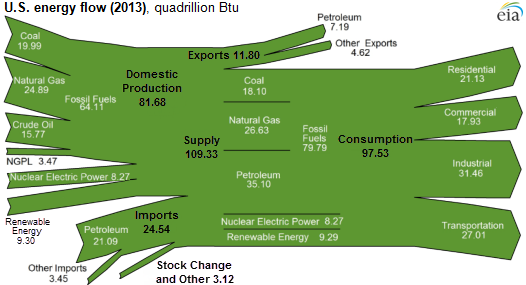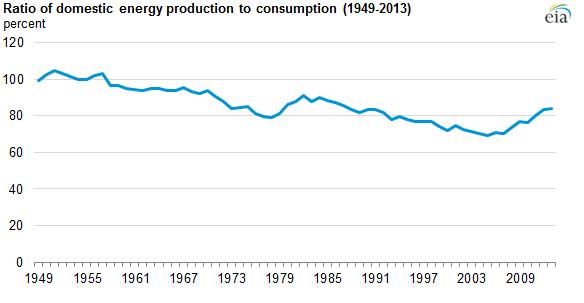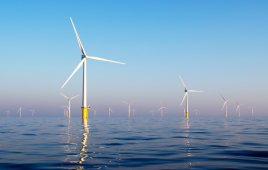Total U.S. energy production reached 81.7 quadrillion British thermal units (quads) in 2013, enough to satisfy 84% of total U.S. energy demand, which totaled 97.5 quads. Natural gas was the largest domestically produced energy resource for the third year in a row and, together with the other fossil fuels (coal, crude oil, and hydrocarbon gas liquids), accounted for more than three quarters of U.S. energy production. In total, the United States consumed 97.5 quads of energy, 82% of which was fossil fuels. Renewable and nuclear energy made up 10% and 8%, respectively, of U.S. energy consumption.

Source: U.S. Energy Information Administration, Monthly Energy Review, May 2014
Note: Supply equals domestic production, plus imports, plus stock change and other. Consumption equals supply minus exports.
The portion of U.S. energy consumption supplied by domestic production has been increasing since 2005, when it was at its historical low point (69%). Since 2005, production of domestic resources, particularly natural gas and crude oil, has been increasing as a result of the application of technologies that can develop harder-to-produce resources. At the same time, reduced road travel, improved vehicle efficiency, and competition among fuels for electric power generation have limited consumption of petroleum and coal.

Source: U.S. Energy Information Administration, Monthly Energy Review, May 2014
Note: A ratio of greater than 100 can occur when the United States is a net energy exporter or when there are net additions to stored energy.
The last significant rise in the ratio of domestic production to consumption occurred from 1978 to 1982. During that period, oil consumption declined in response to higher prices and changing policies, and production rose as oil started to flow from Alaska’s North Slope. At the same time, domestic coal production was increasing.
Principal contributors: Mary Joyce, Ryan Repice
EIA
www.eia.org
Filed Under: News, Policy




